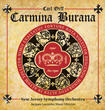 This work is one of my favorites! I enjoyed researching it and was quite amused at the subject matter I uncovered! Click on the NPR story at the end of the article for the fun details!
This work is one of my favorites! I enjoyed researching it and was quite amused at the subject matter I uncovered! Click on the NPR story at the end of the article for the fun details!
- A secular oratorio written in 1937
- Based on a manuscript of medieval poems
- Intended to be staged with dance
- Part of a trilogy: Catuli Carmina, 1943 and Trionfo de Afrodite, 1953
- The work is divided into three parts: The first part, “Primo Vere” (“In Early Spring”), presents youthful, energetic dances; the second part, “In Taberna” (“In the Tavern”), evokes drunken feasting and debauchery; and courtship and romantic love are the subject of the third part, “Cour d’Amours” (“Court of Love”).
“I think the word excess probably captures this piece. And I think that again draws people in, because there’s something about talking about the excesses in life and the edges that is very appealing.” – Conductor Marin Alsop, Music Director of the Baltimore Symphony Orchestra
Resources:
